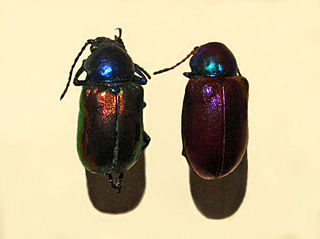
The insects of the beetle family Chrysomelidae are commonly known as leaf beetles, and include over 37,000 species in more than 2,500 genera, making up one of the largest and most commonly encountered of all beetle families. Numerous subfamilies are recognized, but the precise taxonomy and systematics are likely to change with ongoing research.

The Eumolpinae are a subfamily of the leaf beetles, or Chrysomelidae. It is one of the largest subfamilies of leaf beetles, including more than 500 genera and 7000 species. They are oval, and convex in form, and measure up to 10 mm in size. Typical coloration for this subfamily of beetles ranges from bright yellow to dark red. Many species are iridescent or brilliantly metallic blue or green in appearance.

The Synetinae are a small subfamily within the leaf beetle family (Chrysomelidae). They are found entirely within the Holarctic, mainly in North America but also appearing in parts of Europe and Asia. The subfamily contains only two genera, Syneta and Thricolema, with a total of 12 described species. The group is sometimes treated as a tribe of Eumolpinae, where they are known as Synetini.

Onthophagus is a genus of dung beetles in the Onthophagini tribe of the wider scarab beetle family, Scarabaeidae. It is the most species-rich and widespread genus in the subfamily Scarabaeinae, with a global distribution.

Chrysochares asiaticus is a species of beetles belonging to the leaf beetle family, subfamily Eumolpinae.

The Spilopyrinae are a small subfamily of the leaf beetles, or Chrysomelidae. They occur in Australia, New Guinea, New Caledonia and Chile. They were formerly considered a tribe of the subfamily Eumolpinae. The group was elevated to subfamily rank by C. A. M. Reid in 2000. However, some authors have criticised this placement, preferring to retain them within the Eumolpinae.
Macrocoma bezdeki is a species of leaf beetle endemic to Socotra. It was described by Stefano Zoia in 2012. It is named after Jan Bezděk, a collector of the specimens studied and also a specialist in the leaf beetle subfamily Galerucinae.
Gressittana is a genus of leaf beetles in the subfamily Eumolpinae. It contains only one species, Gressittana sculpturata, which was originally placed in Rhyparida. The genus is endemic to New Guinea, and is named after Judson Linsley Gressitt.

Colaspidea is a genus of leaf beetles in the subfamily Eumolpinae. It is known from North America and the Mediterranean. It has recently been suggested that the Mediterranean species of Colaspidea are a sister genus to Chalcosicya, and that Colaspina forms a sister genus to the former two combined. It has also been suggested that the North American species may represent a separate genus.
Iviva is a genus of leaf beetles in the subfamily Eumolpinae. It is distributed in New Guinea, and it is named after the type locality of the type species, Lake Iviva (Sirunki), in the Western Highlands province of Papua New Guinea.
Nakanaia is a genus of leaf beetles in the subfamily Eumolpinae. It contains only one species, Nakanaia depressicollis. It is found on the island of New Britain in Papua New Guinea. The genus is named after the type locality of the type species, the Nakanai mountains.
Stizomolpus is a genus of leaf beetles in the subfamily Eumolpinae. It contains only one species, Stizomolpus kebarus. It is distributed in New Guinea. The name of the genus refers to the strong punctures and "eumolpine beetle".
Rhynchomolpus is a genus of leaf beetles in the subfamily Eumolpinae. It is distributed in New Guinea, and the name refers to its resemblance to a snout beetle.
Sedlacekia is a genus of leaf beetles in the subfamily Eumolpinae. It contains only one species, Sedlacekia pandani. It is distributed in New Guinea. The genus is named after Josef and Marie Sedlacek, who collected part of the type material.
Coniomma is a genus of leaf beetles in the subfamily Eumolpinae. It contains only one species, Coniomma hospes, and is endemic to the island of Luzon in the Philippines. The genus and species were first described by Julius Weise in 1922, and were re-described in 2011 by A. G. Moseyko. The genus is very closely related to Rhyparida.
Bechyneia is a genus of leaf beetles in the subfamily Eumolpinae. It contains only one species, Bechyneia spinosa, which is found in South Africa.
Rhodopaea is a genus of leaf beetles in the subfamily Eumolpinae. It originally contained only one species, Rhodopaea angelovi, which is paleoendemic to the western Rhodopes of Bulgaria. In 2019, a second species, Rhodopaea heinzi, was described from northwestern Anatolia in Turkey.
Diconerissus is a genus of leaf beetles in the subfamily Eumolpinae. It contains only one species, Diconerissus lepersonneae, found in the Democratic Republic of the Congo. It was first described by the Belgian entomologist Louis Jules Léon Burgeon in 1941.
Agetinella is a genus of leaf beetles in the subfamily Eumolpinae. It contains only one species, Agetinella minuta, which is known from Swan River in Western Australia. The genus and species were first described by the German entomologist Martin Jacoby, in an article posthumously published in 1908. The genus was originally assigned to the tribe Eumolpini, but later leaf beetle classifications instead place it as incertae sedis within Eumolpinae.







